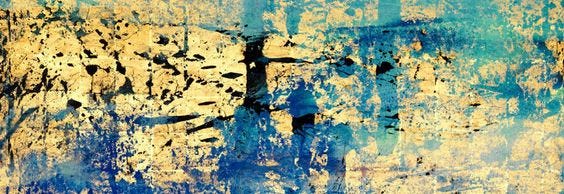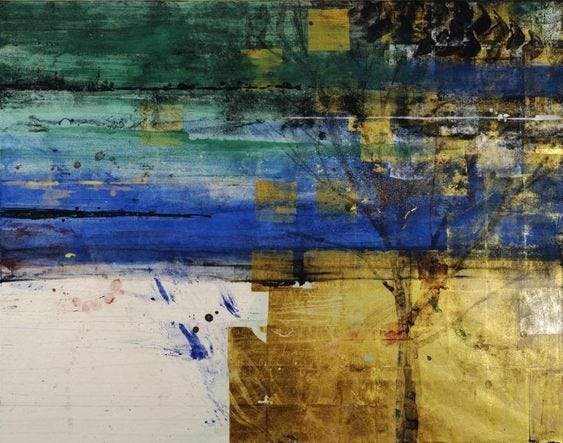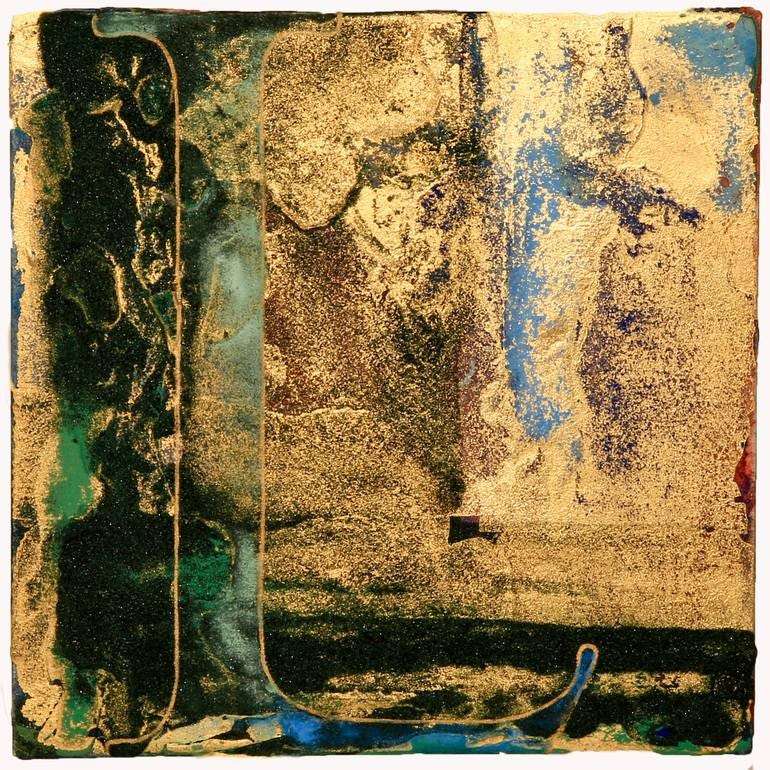“There are burning bushes everywhere, burning yet not consumed, and our lives can be just as miraculous. Our Making can be a visible marker of God’s gratuitous love.”
So writes Makoto Fujimura in his book Art + Faith: A Theology of Making. I knew nothing about his artwork when I bought his book. But, always interested in the way art and faith and spirituality intersect, I wanted to see what he had to say.
Then I discovered his paintings and was stunned by the beauty I found.
He practices the ancient technique of Nihonga. His pigments are semi-precious stones crushed, such as azurite, malachite, cinnabar pigments, coarsely grounded. He writes:
“I use them not just because they are beautiful, which they are, but because they have this wonderful lineage. I use them because of the specific symbolism attached to them. For me, mineral pigments have significance as symbols; they symbolize God’s spiritual gifts to people . . . . When you look closely at these paintings you see that they have a peculiar surface–they glitter and shine. Crushed minerals, therefore, symbolize gifts both from heaven and earth, and point to my deeper struggle to return the gifts given to the Creator.”
Fujimura quotes a passage from George Eliot’s Middlemarch:
“If we had a keen vision and feeling of all ordinary human life, it would be like hearing the grass grow and the squirrel’s heart beat, and we should die of that roar which lies on the other side of silence.”
He believes it’s the artist’s mission to listen to the mystery of things and to be touched by the “keen vision and feeling” of God’s creation.
“This experience ‘of the other side of silence’ is the timeful potential of art, which is what the Greeks called kairos, an ‘eternal time.’”
He writes about the artist’s capacity to know “both the depths of sorrows and the heights of joy.” To “feel deeply the wounds and agony of life with its explosive potential.” To reveal “the roar which lies on the other side of silence.”
In connecting art to Making, Fujimura broadens the word art to apply to every human being’s act of making:
“We are all artists in that sense. Let us reclaim creativity and imagination as essential, central, and necessary parts of our faith journey. Imagination is a gift given to us by the Creator to steward, a gift that no other creature under heaven and earth (as far as I know) has been given.”
There are burning bushes everywhere in our lives to inspire us in our Making, if only we would open our eyes and see. And remember to remove the sandals from our feet when doing so, for the place we are standing is holy ground.
Please share this post with other artists and writers or anyone engaged in the creative process.
Whatever our spiritual inclinations, as humans we are all engaged in the act of Making, whether it’s making our beds or dinner for friends, building a career or creating a family. There is an underlying sacredness to all we do, if we do it with love.
What kind of making are you engaged with? What inspires you in that making? Do you “hear the roar that lies on the other side of silence?” I’d love to hear your thoughts on any of this.









Stunning artworks that I would love to see in person. They demand up-close inspection of the layers and materials used and standing back to appreciate the image as a whole and their scale.
I like Fujimura's quote about creativity and imagination. I, firmly believe, that the creative process is amongst the highest levels of thinking humans can do. Yet, schools unteach creativity. Children grow up with an enormous amount of untapped creativity, and at some point, that tap is turned off. It's not that the well is empty, it's because school teaches the opposite. Blend in, Conform, Standardized testing, Grading policies rooted in inequity and rarely allow for creative solutions to the prompt, etc., etc. Parents also embrace this by financially awarding report card grades, placing stress on their children by talking about college at a young age (as do schools!), how much money one makes is often viewed as a success in our culture (and yet, education costs so much and puts many on a path of lifetime debt!). And, of course, they compare themselves to others who they think are better rather than taking the time to explore their voice.
We are constantly told to conform and blend in. Don't explore - do it this way, not that way. Mimic the teacher, parent, mainstream society, and "learn."
As a high school art teacher, I am very aware of this and openly discuss it with my students. I want them to trust the process, take risks, explore, if something new happens - go with it and embrace mistakes along the way, and learn from them, don't make it for me or a grade - be honest with your art and make it for you! The process of exploration and creating not only teaches us the most, but it is always more important than the final product. Ultimately, most all receive the grade they deserve (and want). More importantly, tho - they explored being creative.
Robert Pirsig's 'Zen & The Art of Motorcycle Maintenance' talks at length about this very topic. It's a book I read at 17, but I couldn't quite grasp its message. I re-read it in my 20s or 30s and understand it more. However, I re-read it last summer at 54 and found it inspirational and illuminating. Sure, it is dated, but Pirsig's overall message is spot-on.
Thank you for introducing me to Makoto Fujimura.
This art is stunning! I am reminded of that quote from Picasso about how every child is an artist. He noted that the problem was remaining an artist as we grow up. I suspect we (I) get too glazed over, too busy , to see with new eyes. And I love that idea of hearing "the roar that lies on the other side of silence". I once painted a series that I called my "Milky Way Gallery" - 16x20 acrylic pieces of each planet + Pluto + moon and sun. I got lost in those days of painting (I think it took me several months to work through them all) and definitely touched the other side of silence. Thank you for an inspiring piece.